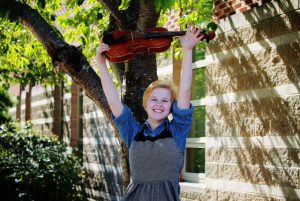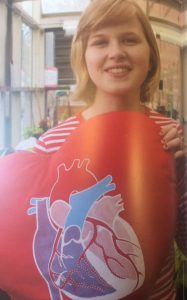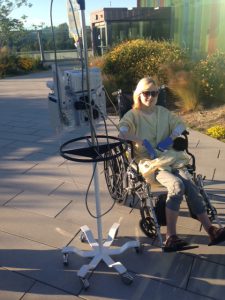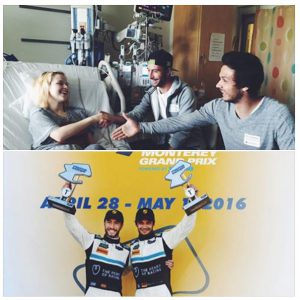
Isabella (Bella) Anderson, 18, was running out of time. Her heart was failing and doctors didn’t know how much more it could withstand. She needed a change in luck and some good news.
Finally, Bella got just that: a surprise and the news she’d been waiting for.
A long road to transplant
At only 10 years old, Bella went to see the doctor for strep throat, but doctors found something more alarming: a heart murmur. She was diagnosed with hypertrophic cardiomyopathy, a disease of the heart muscle’s wall.
From that day forward, she was monitored closely by Seattle Children’s Heart Center, one of the best pediatric cardiology and cardiac surgery programs in the U.S., and the top-ranked program in the Pacific Northwest, according to U.S. News & World Report.
Unfortunately, as time progressed, so did her heart condition. Cardiomyopathy reduces the heart’s ability to pump blood effectively and can lead to congestive heart failure.
Slowly, her heart began to fail.
A failing heart, an abnormal rhythm
In 2013, Bella’s heart disease did something rare: it changed. For years, the main issue with her heart was the thickness of its walls, but overt time her symptoms began to act more like a different heart condition, dilated cardiomyopathy.
 “It’s pretty abnormal for that to happen,” said Dr. Mariska Kemna, a cardiologist at Seattle Children’s. “It only occurs in about 5% of patients. She has a very different story than most with this condition.”
“It’s pretty abnormal for that to happen,” said Dr. Mariska Kemna, a cardiologist at Seattle Children’s. “It only occurs in about 5% of patients. She has a very different story than most with this condition.”
A subcutaneous Implantable Defibrillator (S-ICD), similar to a pacemaker, was implanted under Bella’s skin in her chest at the University of Washington Medical Center, which partners with Seattle Children’s in the care of older adolescents. She was one of the first children to have a defibrillator implanted directly under her skin instead of in the great vessels of her chest. The device sends electrical shocks to the heart to treat an abnormal heartbeat, or arrhythmia. Her cardiologists became weary her heart condition wasn’t going to improve and the device would be able to shock her out of dangerous heart rhythms, if they were to occur.
“We thought her heart might be able to stabilize,” said Kemna. “We needed to be absolutely sure she needed a transplant.”
In February 2016, doctors made a choice with Bella and her family. It was time to place Bella on the transplant list. She was listed under a status of mid-urgency.
“She’s incredibly mature for her age and always thinks about other people,” said Kemna. “I remember when we were talking about the transplant listing; I was explaining what the different statuses meant. She looked at me and said, ‘I wouldn’t have it any other way. I wouldn’t want to get a heart if someone else needs it more.’”
A stroke at a young age
Unfortunately, on March 19, it became evident that Bella needed an upgraded status. After almost three years of having the S-ICD, the device fired for the first time.
“It was like someone punched me in the chest,” said Bella.

Bella was rushed to Seattle Children’s where she was admitted to the Cardiac Intensive Care Unit (CICU). She stayed inpatient at the hospital for a little more than a week before heading home again.
“It saved her life, but it was a sign that her heart was getting worse,” said Kemna.
Her time away from the hospital was short lived. On April 5, 2016, around 9 p.m., she began experiencing strange symptoms.
“I jokingly said to my dad, ‘I think I’m having a stroke,’” said Bella.
Unfortunately, that’s exactly what was happening.
“The incidence of childhood stroke is about 10 per 100,000 per year,” said Dr. Catherine Amlie-Lefond, director of the Pediatric Vascular Neurology Program at Seattle Children’s Hospital, the only pediatric vascular neurology program in the Pacific Northwest, “but is more common in children with heart disease.”
Bella’s left arm went numb and her face began to droop – common symptoms of a stroke. Stroke happens when blood that carries oxygen and nutrients stops flowing to parts of the brain. Without a steady supply of blood, brain cells in the area begin to die within minutes. Stroke can sometimes lead to lasting neurologic deficits or even death. When it comes to a stroke, early detection is key.
“Time equals a loss in brain function,” said Amlie- Lefond. “At the onset of her stroke symptoms, the family went straight to the emergency room. Without that, she wouldn’t have had a chance.”
Within minutes of her father dialing 911, an ambulance had arrived to their home and transported Bella to Seattle Children’s emergency room.
After she was stabilized, Seattle Children’s staff contacted their partners at Harborview Medical Center where the endovascular team awaited her arrival to remove the blood clot as soon as possible using a specialized catheter.
“I can tell families that I have seen many children with stroke, but Bella has other ongoing medical issues, which made her case more dire,” said Amlie-Lefond. It’s a terrible situation for any family to go through. Fortunately for Bella, the fast responses of the family, Seattle Children’s Hospital, and the stroke team at Harborview Medical Center prevented her stroke from causing permanent damage.”
In the hospital for the long haul
Bella soon returned to Seattle Children’s. She had a stroke with no evidence of damage to her brain, but her heart was another problem all together. Her only hope was a transplant.
“It was one complication after the next,” said Kemna. “We decided to keep her in the hospital because her heart was getting so sick so quickly.”

Hospital stays can be difficult for children and teenagers, especially when there is no clear end in sight. Luckily for Bella, she had visitors to help brighten her days, including two race car drivers, Alex Riberas and Mario Farnbacher, from The Heart of Racing, a guild that has raises money for Seattle Children’s Heart Center. To date, they’ve raised more than $5 million for Seattle Children’s.
“I wasn’t feeling very well one day after a blood draw,” said Bella. “The nurses pulled up photos of the racecar drivers and said, ‘Would you like to meet them?’ Apparently, the photos got my heart rate up.”
The next day, two racecar drivers strolled into Bella’s room.
“It was a good distraction and it really made my day,” said Bella.
The trio chatted for nearly an hour. As they left they made Bella a promise: “We’ll try to win for you.”
A week later, Riberas and Farnbacher made good on their word to Bella. The Heart of Racing won at Laguna Seca, the Continental Monterey Grand Prix.
A prom just for Bella
For nearly two months, Seattle Children’s became like a home for Bella and the care team became like her family. She had hoped to be out of the hospital by June 4, the day of her senior prom – a milestone she was determined to not miss. But unfortunately, to her disappointment, she was unable to go.

To lift Bella’s spirits, her mother and care team brought prom to her.
“I have a daughter around the same age as Bella,” said Dr. Harris Baden, a physician who treated Bella in the Cardiac Intensive Care Unit (CICU). She attended her prom the night before. I know how special it was for her, so I wanted to do whatever I could to make Bella feel special too.”
Baden came in on his night off to surprise Bella with a handmade corsage and a bottle of sparkling cider. That, however, wasn’t her only surprise that night.
Bella’s mother bought her a dress, her sisters did her hair and nails and two of her favorite nurses escorted her up to the rooftop garden at Seattle Children’s for her very own, private prom.
“There are not many people in the world who can say they had a prom like this,” said Bella. “It was truly unique.”
She even had a prom date, nurse Jose (Danny) Olivera. They danced, they listened to music and they watched the sunset from the rooftop.
“That night will forever be one of my favorite memories of all time,” said Bella’s mother, Molly. “After that night, Bella looked me in the eyes and said, ‘I can do this now.’ She said it was just what she needed. She was ready for the transplant.”
The news Bella had been waiting for and a goal to make it to graduation
The very next day, on June 5, news finally came. They had a heart.
“We’ll be forever grateful to her donor,” said Bella’s mother. “When I first talked to Bella about it she said to me, ‘I can’t believe someone has to die for me to live,’ but I look at it differently. I believe part of someone will live on.”

Cardiologists at Seattle Children’s will monitor her heart closely for the next few months, but according to Kemna, her outlook is good.
“She will have to take medication the rest of her life so her body doesn’t reject her heart, but she should feel like a million bucks compared to when she was sick,” said Kemna.
“If we didn’t have confidence in the care we received here, this experience would have been a nightmare,” said Bella’s mother. “But she was in the best hands and we’re incredibly thankful. Each and every caregiver we’ve encountered has our deepest affection and appreciation. Seattle Children’s is a very special place.”
As Bella recovers, there is one other key milestone her care team is determined to help her not miss: her high school graduation.
“We are doing all we can to make sure she gets to attend to her graduation,” said Dr. Mike McMullan, surgical director of Heart Transplantation at Seattle Children’s. “She’s been through so much this year, it would mean a lot to see her accomplish such a goal.”
Resources:
- Seattle Children’s Heart Center
- Seattle Children’s Pediatric Vascular Neurology Program

